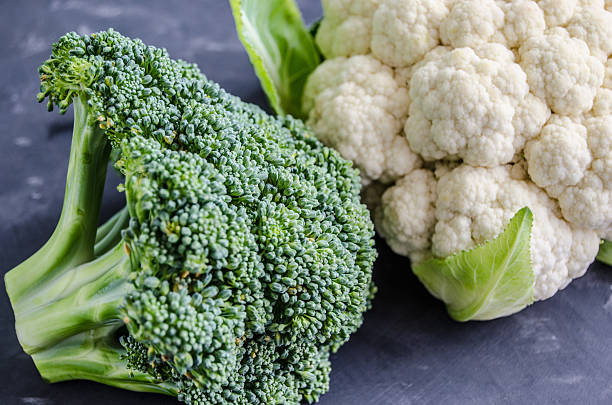Close-Up of Cauliflower and Broccoli

Close-Up of Cauliflower and Broccoli
Cauliflower and broccoli are two of the most commonly consumed members of the Brassicaceae family, a large family of plants known for their nutrient-dense, fiber-rich, and antioxidant properties. Though they share the same genus (Brassica), these two vegetables differ in appearance, flavor, and texture, yet both offer a similar set of health benefits. A close-up look at these vegetables reveals a world of intricate details that make them both fascinating and nutritious.
Cauliflower: A Unique, Crystalline Structure
Cauliflower is immediately distinguishable from other vegetables due to its compact, white “curd” or head, which is made up of tightly packed flower buds. This head is not a single flower but rather a cluster of undeveloped flower structures. In a close-up view, the cauliflower’s surface resembles a network of delicate, white, tree-like branches, which form a spiraling pattern that converges at the center of the head. Each of these small, tightly packed florets, called “curd,” is composed of immature flower buds that, if left to grow, would eventually bloom into tiny yellow flowers.
The compactness of the cauliflower head is an adaptation that helps protect the developing buds from pests and environmental damage. The head’s purity and firmness give it a delicate yet slightly granular texture when bitten into. Its flavor, when examined closely, is mild and slightly nutty, making it a versatile vegetable that can be used in a variety of culinary applications, from raw salads to roasted dishes.
The color of the cauliflower, although typically white, can also come in other shades. Orange, purple, and green varieties of cauliflower exist, each containing different amounts of phytonutrients, such as carotenoids in orange cauliflower, which give it its color and boost its antioxidant properties. Purple cauliflower contains anthocyanins, which provide its distinctive hue and also offer additional health benefits, including anti-inflammatory properties.
Despite its mild flavor, cauliflower can take on a variety of textures when prepared in different ways. Roasting cauliflower caramelizes its surface, adding a sweet, nutty depth to its flavor. Steaming it, on the other hand, preserves its delicate, soft texture, while raw cauliflower is often used as a crunchy addition to salads and dips.
Broccoli: A Green, Robust Beauty
Broccoli, in contrast, is a vivid green vegetable with a much more striking appearance than cauliflower. A close-up view of broccoli reveals a large, sturdy stalk that rises from the base, branching into a series of smaller stems, each ending in a cluster of tightly packed florets. These florets, resembling small trees, are made up of immature flower buds, which would eventually bloom into small, yellow flowers if the broccoli is left unharvested. The broccoli florets are generally smaller than those of cauliflower and are arranged in a more open, tree-like structure.
The color of broccoli, which ranges from pale green to a darker, forest-like shade, is one of its most striking features. This green hue comes from the high chlorophyll content in the plant’s leaves and florets. Chlorophyll is not only responsible for the green color but also acts as a powerful antioxidant, offering protective health benefits, including the potential to help reduce the risk of certain cancers.
Broccoli’s texture is firmer and more fibrous compared to cauliflower, making it ideal for both cooking and raw applications. When examined closely, the florets have a soft, velvety surface, while the stems are crisp and tender when cooked correctly. The heads of broccoli are often consumed as the main portion, though the stems are also edible and contain a higher amount of fiber and vitamins than many people realize. Broccoli can be prepared in a variety of ways: steaming, stir-frying, roasting, or even eaten raw. Each method brings out a different characteristic of the vegetable, whether it’s the crispy crunch of raw broccoli, the softened texture of steamed broccoli, or the caramelized sweetness of roasted broccoli.
Broccoli, especially when it’s fresh, has a slightly bitter taste with a robust, earthy undertone. The bitterness is most noticeable when the vegetable is overcooked, which is why steaming or blanching broccoli to a tender yet crisp texture helps preserve its flavor profile. The bitterness is due in part to compounds known as glucosinolates, which are found in high concentrations in cruciferous vegetables like broccoli and cauliflower. These compounds have been studied for their potential to reduce cancer risk and provide other health benefits, such as aiding in detoxification and supporting immune health.
Comparing the Two Vegetables
While both cauliflower and broccoli belong to the same plant family, their contrasting characteristics make them unique in their own right. The most obvious difference is in their appearance. Cauliflower has a dense, white head of tightly packed florets, whereas broccoli has a branching, tree-like structure with green florets. Broccoli’s appearance is more open and expansive, while cauliflower tends to look more compact and uniform. These visual differences also influence their culinary applications. Cauliflower is often used as a replacement for grains and legumes in low-carb diets, thanks to its neutral flavor and ability to take on the taste of other ingredients. Broccoli, on the other hand, is commonly used in stir-fries, soups, and salads, where its texture and flavor can shine through.
The flavor of cauliflower is milder compared to the bolder, earthier taste of broccoli, which has a slightly bitter edge. This makes cauliflower more versatile, as it can easily be incorporated into dishes without overwhelming other flavors. Broccoli’s stronger taste, while often appreciated by many, is not as universally favored and requires more care when pairing it with other ingredients.
Both vegetables are highly nutritious, offering significant amounts of vitamins, minerals, and antioxidants. They are rich in vitamin C, fiber, and folate, and they contain various phytochemicals, including glucosinolates, that are believed to support overall health and protect against disease. Broccoli, with its higher chlorophyll content, also provides a significant amount of vitamin K, which is essential for bone health, while cauliflower has a higher content of antioxidants like beta-carotene.
Conclusion
A close-up view of cauliflower and broccoli reveals the incredible variety and complexity hidden beneath their seemingly simple exteriors. These vegetables, though visually and texturally different, share a similar family tree, offering a wide range of culinary and health benefits. Whether consumed raw, steamed, roasted, or incorporated into other dishes, cauliflower and broccoli remain two of the most beloved vegetables, celebrated for their versatility, flavor, and nutrient density.




